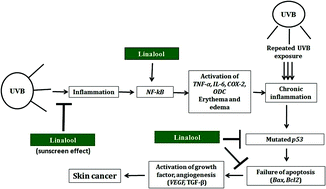The preventive effect of linalool on acute and chronic UVB-mediated skin carcinogenesis in Swiss albino mice
Abstract
In this study, we evaluated the role of linalool in acute ultraviolet-B (UVB; 280–320 nm) radiation-induced inflammation and chronic UVB-mediated photocarcinogenesis in mouse skin. Acute UVB-irradiation (180 mJ cm−2) causes hyperplasia, edema formation, lipid peroxidation, antioxidant depletion, and overexpression of cyclooxygenase-2 (COX-2) and ornithine decarboxylase (ODC) in mouse skin. Topical or intraperitoneal (i.p.) treatment of linalool prevented acute UVB-induced hyperplasia, edema formation, lipid peroxidation, and antioxidant depletion in mouse skin. Further, linalool treatment prevented UVB-induced overexpression of COX-2 and ODC in mouse skin. In the chronic study, mice were subjected to UVB-exposure thrice weekly for 30 weeks. Chronic UVB-exposure induced tumor incidence and expression of proliferative markers such as NF-κB, TNF-α, IL-6, COX-2, VEGF, TGF-β1, Bcl-2 and mutated p53 in mouse skin. Treatment with linalool before each UVB-exposure significantly prevented the expression of these proliferative markers and subsequently decreased the tumor incidence in mice skin. Histopathological studies confirmed the development of dysplasia and squamous cell carcinoma (SCC) in the chronic UVB-exposed mouse skin; and this was prevented by both topical and i.p. linalool treatment. Therefore, linalool may be considered as a photochemopreventive agent against UVB radiation induced skin carcinogenesis.


 Please wait while we load your content...
Please wait while we load your content...